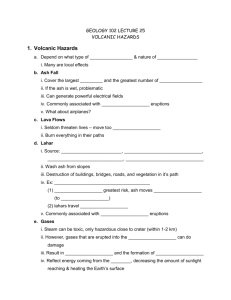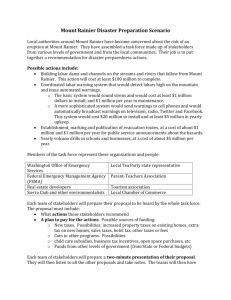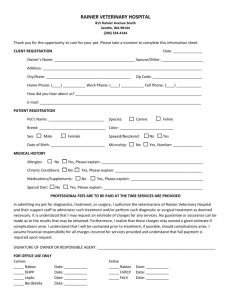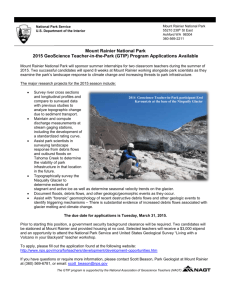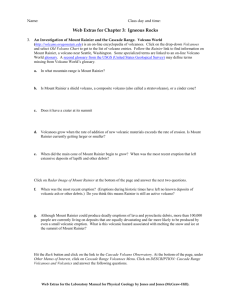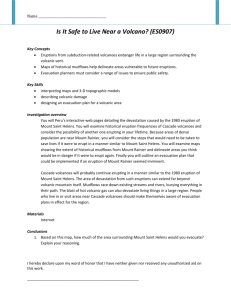Volcanic Hazards at Mt. Rainier
advertisement
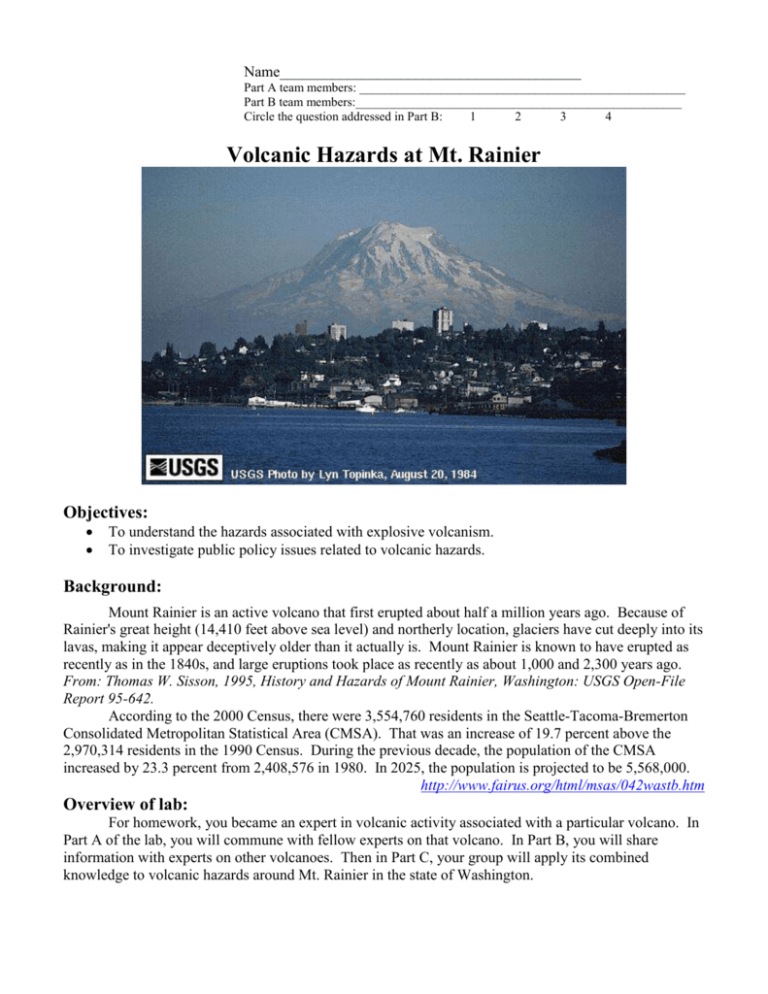
Name________________________________________ Part A team members: ____________________________________________________ Part B team members:____________________________________________________ Circle the question addressed in Part B: 1 2 3 4 Volcanic Hazards at Mt. Rainier Objectives: To understand the hazards associated with explosive volcanism. To investigate public policy issues related to volcanic hazards. Background: Mount Rainier is an active volcano that first erupted about half a million years ago. Because of Rainier's great height (14,410 feet above sea level) and northerly location, glaciers have cut deeply into its lavas, making it appear deceptively older than it actually is. Mount Rainier is known to have erupted as recently as in the 1840s, and large eruptions took place as recently as about 1,000 and 2,300 years ago. From: Thomas W. Sisson, 1995, History and Hazards of Mount Rainier, Washington: USGS Open-File Report 95-642. According to the 2000 Census, there were 3,554,760 residents in the Seattle-Tacoma-Bremerton Consolidated Metropolitan Statistical Area (CMSA). That was an increase of 19.7 percent above the 2,970,314 residents in the 1990 Census. During the previous decade, the population of the CMSA increased by 23.3 percent from 2,408,576 in 1980. In 2025, the population is projected to be 5,568,000. http://www.fairus.org/html/msas/042wastb.htm Overview of lab: For homework, you became an expert in volcanic activity associated with a particular volcano. In Part A of the lab, you will commune with fellow experts on that volcano. In Part B, you will share information with experts on other volcanoes. Then in Part C, your group will apply its combined knowledge to volcanic hazards around Mt. Rainier in the state of Washington. Part A. Becoming an expert Separate the class into four groups based on the pre-lab volcanoes. Mount Pinatubo, Philippines: 1991 eruption Mt. Pelee, Martinique, West Indies: 1902 eruption Mt. St Helens: 1980 eruption Nevada del Ruiz, Columbia: 1985 eruption Review the pre-lab assignment for your volcano; compare and supplement each others’ knowledge. Each member of the group should be an expert on the particular volcano. Part B. Teaching your classmates Form new groups, each with an expert on the 4 volcanoes. Each person will make a presentation covering their Part A work to the rest of the group. Other group members should listen and ask questions until all are familiar with the main points of the 4 volcanoes. Part C. Volcanic Risk at Mount Rainier Your lab instructor will review a PowerPoint presentation with information about volcanic hazards associated with Mt. Rainier. Any part of this presentation is also available for you to use in your work below. 1. Preparing oral presentations Your Part B panel of experts has been called to testify before Washington Governor Christine Gregoire's Volcanic Risk Commission about the situation at Mt. Rainier. It is chaired by State Senator Skeptical *68, who never took a geohazards course when he was at Princeton. You have been asked to prepare a 10-minute oral presentation on a particular volcanic hazard; some considerations are on the next page. You will be graded on a) how well this presentation addresses the hazard, b) how effectively you incorporate information from the four homework volcanoes, and c) how applicable your presentation is to Mt. Rainier. Remember: Focus on the hazard assigned to your panel. All group members must participate in the presentation, and information from each group member must be incorporated. Your presentation must have serious content, but feel free to have some fun with the role-playing and consider/present different points of view. Use Google Earth and/or maps, diagrams, etc. as appropriate for your presentation. Make up overheads if you like (materials provided). Prepare and turn in to your lab instructor, a 1-page outline of your group presentation with main points summarized in bullet or outline form, along with any illustrations used. 2. Oral presentations and follow-up questions Each group gives their presentation. After each group presents, they will respond to questions from the class and instructor. Presentation Topics: Recall the risk equation: Risk = Hazard x Vulnerability x Value Assume that the hazard at Mt. Rainier is 1.0 ( Mt. Rainier will erupt again). Now consider the vulnerability and value associated with the following volcanic phenomena: Pyroclastic flows What are pyroclastic flows and what is the risk (vulnerability x value) of pyroclastic flows around Mt. Rainier? Are there people and property in the way of pyroclastic flows? On Hawaii, there is plenty of time to warn people and get them out of the way of lava flows, so why can’t we do the same thing at Mt. Rainier? What do you suggest to mitigate the effects of pyroclastic flows both now before Mt. Rainier erupts, and also during an actual eruption? Lahars Focus on towns along the rivers to flowing away from Mt. Rainier, e.g. the towns of towns of Puyallup (population 27,788) and Orting (population 3300), 20-30 miles away from the volcano along the Puyallup River. If Mt. Rainier were to erupt, what is the risk (vulnerability x value) of lahars? On Hawaii, there is plenty of time to warn people and get them out of the way of lava flows, so why can’t we do the same thing at Mt. Rainier? What do you suggest to reduce casualties and property loss due to lahars, both now before Mt. Rainier erupts, and also during an actual eruption? Volcanic Ash During some volcanic eruptions, huge ash clouds erupt, throwing material into the air that comes down all over the place. But isn’t this just rock dust and not particularly toxic? So what’s the risk - what's the big deal about a bit of dust? And anyway, not all volcanoes have big ash eruptions -Hawaiian and Icelandic volcanoes are among the most active in the world, but you never hear about dust clouds associated with them. So what is the risk (vulnerability x value) of volcanic ash at Mt. Rainier? What do you suggest to reduce casualties and property loss due to volcanic ash, both now before Mt. Rainier erupts, and also during an actual eruption? Lava What is the risk (vulnerability x value) of lava flows at Mt. Rainier. On Hawaii, there is plenty of time to warn people and get them out of the way of lava flows, so why can’t we do the same thing at Mt. Rainier? Would the heat of lava flows affect the glaciers on Mt. Rainier increase risk? What do you suggest to reduce casualties and property loss due to lava flows both now before Mt. Rainier erupts, and also during an actual eruption?
